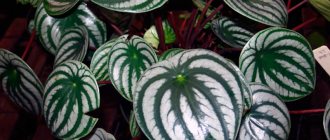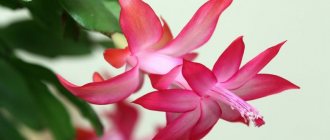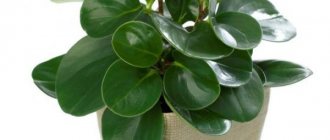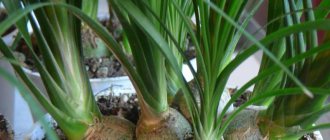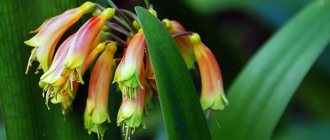Home » Flowers and plants
Vladimir 02.22.2018
10431 View
Peperomia is an evergreen perennial of the Pepper family. Most peperomia are ornamental plants and are used for interior design of residential premises and botanical gardens. Growing peperomia domestica is a fairly simple task and can be done without any difficulties.
External features
In terms of appearance, peperomia comes in several different varieties, ranging from compact and almost dainty to something bolder with thick, colorful leaves. Leaves can come in different colors, shapes and textures.
Even the growth habit can vary, from small compact and rounded varieties to taller upright ones, right up to a number of climbing peperomia. Check out the photo of peperomia and you will fall in love with this plant, and this exquisite indoor flower will delight you with its unusual beauty for many years.
All this variety means that the number of different varieties of peperomia you can buy is huge and incredibly varied, so much so that if you put them side by side you might think you're actually looking at completely different plants!
general information
Peperomia is a pepper plant, and this is easy to understand by its name. It grows in equatorial and tropical latitudes, and it is almost impossible to unite all hundreds of species with a common characteristic. Among them there are shrubs, herbs, succulents, ampelous plants, epiphytes - anything.
Almost all types of peperomia have thick, elastic stems, densely covered with dense, fleshy leaves. The plant stores moisture well, but grows slowly. The shape, shades and sizes are very different from each other. Some varieties are even capable of blooming, but peperomia flowers are not particularly decorative.
Photo: landas.ru
Light
For the most part, indoor peperomia flowers are slow-growing plants that will adapt within reason to the level of light you end up providing. Too much light scorches and washes out the leaves, and too little light will ultimately result in ragged, thin, and unkempt growth.
Peperomias are also one of the few houseplants that tolerate fluorescent light well, so they can be successfully grown permanently in windowless rooms (as long as the indoor light is on most of the day!).
Plant conditions
Soil and container
Considering that the plant is an epiphyte, its roots do not tolerate hard and heavy soil very well. Since the roots of all epiphytes need a lot of air, loose soil is most preferable for them. Thanks to this, the water will quickly reach the roots and will not stagnate.
The plant does not tolerate excess moisture well, so you will need to think about additional drainage of the soil.
Any soil used for succulents or cacti will be suitable for the plant.
If desired, you can also prepare it yourself according to the following scheme:
- leaf soil - 3 parts
- coarse river sand – 1 part
- humus or compost – 1 part
- peat – 1 part
With this ratio in the components, you will get slightly acidic soil, which is ideal for peperomia.
In any case, regardless of the method of obtaining soil, it must be disinfected. It is best to do this in the oven at a temperature of about +100°C.
Then the soil is left in a well-ventilated area without shelter for 10-15 days to restore the microorganisms inhabiting it.
Wrong pot: too low and wide
Pots for plants can be made of any material; the main requirement for them is that there is enough space to accommodate the root system of the plant. The height of the drainage layer for peperomia is from 6 to 8 cm. Accordingly, the height of the pot should be sufficient so that the remaining space is sufficient to accommodate the horse system and substrate.
Lighting
Since the natural conditions for peperomia are the humid, warm climate of the tropics, it is necessary to create precisely these conditions to ensure its normal growth. The plant is located mainly in the lower tiers, so the light reaches it in a diffuse form - this is the kind of lighting that is optimal for it.
Direct sunlight is contraindicated for the plant, so it is best to place it near eastern or western windows
There is no need to use shading or diffusers. If there is a need to place a pot of peperomia on a south window, you can do it that way, however, you should make sure that the light does not fall directly on the plant. For these purposes, you can use some kind of curtains or tulle.
If the plants on the south window are in several rows, peperomia is placed in the second row and so on. The plant requires about 8-10 hours of sun per day. This is fully ensured in the summer, but in winter (more precisely, from October to February) additional lighting will be required.
Peperomia can be grown without sunlight at all, however, it needs about 15-16 hours of artificial light, regardless of the time of year.
Content temperature
Since the plant is native to the tropics, it is thermophilic. Many even consider peperomia to be capricious.
In principle, the conditions in our apartments are quite suitable for Peperomia to be comfortable
The temperature in the warm period should be in the range from +20°C to +22°C, in the cold period from +18°C to +22°C. Plant death occurs at temperatures below +16°C. Such minor changes in temperature in the warm and cold periods are due to the fact that almost all perennial Pepper plants do not have a dormant period as such.
The above temperature limits apply to air, but there are also requirements for the temperature of the substrate. The substrate also has its own range: from +17°C to +20°C. The temperature should be exactly within these limits, no more, no less.
Peperomia in a greenhouse
The metabolism of most tropical plants is such that any changes in “normal” regimes have a detrimental effect on the overall life of the plant and often lead to disease and death.
It is especially important in winter not to overcool the substrate.
To do this, not only should you not place plants in drafts, but also place them on cold window sills. Sometimes wooden or polyurethane stands are used to insulate the plant from the cold base.
Air humidity
It is believed that air humidity is not critical for growing peperomia. However, almost all flower growers are inclined to believe that with more than 50% air humidity, peperomia begins to grow more actively. Perhaps the reason lies in the fact that humidified air is better absorbed by the plant than dry air.
Peperomia will be a great element of your decor
There are also controversial opinions regarding spraying peperomia leaves with a spray bottle. The abundance of hairs can lead to stagnation of moisture in them, and as a result, to leaf rotting or sunburn.
It is recommended to use the following method. Plants that do not have hairs, or those whose hairs are quite sparse, can be sprayed constantly at intervals of 1-2 times a week. Excessively pubescent plants must be sprayed with the same frequency only during the active growing season (from March to May).
In this case, the pot with the plant must be removed from the area where it can get sunburned.
Watering
When studying the question of how to water a flower, be careful, since in this regard it is quite easy to overdo it and create conditions for rotting. You should watch the watering and then wait for the soil to dry out a bit before watering again.
Do not keep the soil constantly wet or allow it to become saturated. At the same time, peperomias are not desert cacti, so be sure to check the situation regularly and provide water when needed. In winter the plant will need very little unless it is particularly warm and bright.
Succulent species
Peperomia dolabriformis
A real succulent with very original leaves. They resemble circles folded in half. There are points at the tips. They are attached to a thick trunk, forming a star-shaped rosette. The leaves reach a length of 7 cm, and a width of about 2 cm. A dark green border is formed at the places where the leaves grow together.
The stems are erect, with few branches, reaching a height of 60 cm. But unlike many relatives, it blooms quite gracefully, producing branched inflorescences with small white-greenish flowers.
Peperomia chisel
Peperomia columella (Peperomia columella) – Column
A very interesting species, striking in the uniqueness of its leaves. Many emerald-colored leaves, similar to dragon scales, densely cover the stem. It grows only 20 cm in height, so it is better to plant the flower in groups. When they reach a certain age, the stems begin to bend in an arched manner, and then they can be planted in pots and used as an hanging plant.
Peperomia columella
Peperomia ferreyrae
A striking representative of epiphytic succulent plants. All the beauty lies in the bright green leaves. They seem to have fused in the middle, and the place of this fusion is highlighted in a darker green color. The height of the plant does not exceed 30 cm, and the leaves can grow up to 7-8 cm in length. Since they contain a large amount of moisture, they are very elastic and thick in appearance. The plant loves moist soil, but does not tolerate stagnant water. Be sure to drain excess water from the pan. If the leaves are heavily dusted, you can make a small tropical rain from the shower with warm water, while being careful not to flood the soil substrate.
Also read: Choosing succulents for planting in the ground in the garden
Peperomia Ferreira
Peperomia graveolens
The modest tropical beauty is one of the succulent species of Peperomia. All the beauty is in the leaves of this plant. Nature has colored them quite bizarrely. The leaves are light green above and ruby or burgundy below. The leaves curl in an arc towards the most upright burgundy trunk. The whole appearance of the plant resembles sea coral, especially when the soil is covered with small sea pebbles. It grows as a small bush, up to 25 cm high. It blooms modestly, with long spikelets with light yellow flowers on long burgundy peduncles.
Peperomia graveolens
Peperomia verticillata
A perennial herbaceous plant, evergreen, with ampelous shoots drooping downwards. It has fleshy leaves of a grayish-green color. The whorled form of leaf attachment gives it its corresponding name. This variety is best propagated by cuttings. During the formation of the crown, you can set aside the cut tops for later rooting.
Peperomia whorled
Humidity
Some representatives of this species require fairly high levels of humidity to maintain their original appearance. However, most indoor peperomia plants thrive without any artificial increase in environmental humidity.
Fine leaves can be difficult to clean, so feel free to mist them when they are warm to keep dust away.
Diseases and pests of peperomia
Almost all diseases arise due to improper care. For example, poor watering or placing peperomia in a cool room can cause foliage to fall. Brown spots appear on the leaves due to drafts and sudden temperature changes, so you should not transport the plant without special shelter. Excess moisture also leads to negative consequences. The leaves turn black, begin to rot and soon fall off, so it is not recommended to place peperomia in a phytofilter. If you do not take the necessary measures in time, the flower may die. Have you noticed that the foliage is turning yellow, wrinkled and withering? This is a sure sign that you have positioned the plant pot incorrectly. It should not be exposed to direct sunlight, because they cause the leaves to fade, and sometimes also leave burns on them.
Peperomia leaves may turn yellow due to exposure to the sun or improper watering, as well as drafts. Peperomia can be affected by fungal diseases, rust spots appear on the leaves
As a rule, pests attack weakened bushes. Peperomia can be parasitized by mites, mealybugs, scale insects and nematodes. It is advisable to get rid of them before they have time to cause harm to the plant. Treatment is carried out by treating with fungicides and transplanting peperomia into steamed soil. Preventing the occurrence of diseases and pests is much easier than dealing with the consequences of infection, so carefully follow the care table.
Bush peperomia is an excellent option for those who want to decorate their apartment with an exotic but unpretentious plant. It is not poisonous, but, on the contrary, helps cleanse the air of many harmful impurities for the human body. Many unusual varieties will help you create unique flower arrangements, so you can bring even your wildest ideas to life.
Join the discussion!
We would be interested to know your point of view, leave your opinion in the comments
